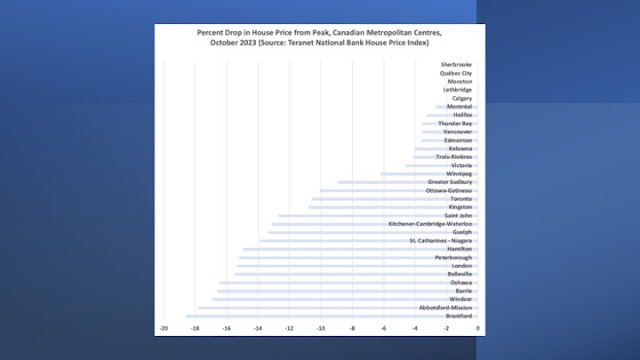Population growth in northern Ontario has been weak over the
last few decades as a result of youth out-migration as well as little immigration
into the region – even though immigration has accounted for over three quarters of
Ontario’s population growth in recent years.
The result has been an aging population and while Ontario had a
population share aged 65 and over of 18 percent in 2021, the province’s North
was closer to 22 percent. A more elderly
population is usually seen as a source of rising demand for services like
health and a cost driver for government.
At the municipal level, seniors are also a source of local income
stabilization given that they still inject some purchasing power into the local
economy and of course continue to pay property taxes.
Yet, in the case of northern Ontario, the earlier waves of youth
out-migration may eventually spawn a new wave of out-migration rooted in seniors
following their children. People in the
50 to 65 age range may be looking ahead and thinking about where and when they
will retire and facing a choice between remaining in the north in retirement or
relocating closer to children. Weighing
in on decisions to stay or go are the need to downsize accommodation and as the
years advance staying in the north is certainly made easier by selling your
house and moving into a condo or apartment.
What is intriguing in the case of condos in northern Ontario is how much
higher priced they are relative to single-detached houses.
Figure 1 plots the median price of a single detached one in
2022 against the median price of an apartment style condo in twelve Ontario
urban areas including Thunder Bay and Greater Sudbury. The median single-detached housing price data
for all twelve cities is from Canadian Real Estate Association web site while
the median condo prices are from the same place with the exception of Thunder
Bay and Sudbury which required creating a separate estimate based on what is
currently available on Mitula or Realtor.ca.
Needless to say, that is not the ideal approach, but it will have to
suffice given data limitations. Figure 1
plots the urban areas from highest to lowest single detached median housing
price and those prices range from a high of $1.425 million for Oakville to a
low of $315,000 for Thunder Bay. What is
more interesting is the accompanying median condo prices which show a lot less
variation than those for houses.

The range in median prices for single detached houses in
these twelve cities is $1.11 million but for condos it ranges from a high of
$648,500 in Greater Toronto to a low of $329,900 in Thunder Bay – a still
consequential but much smaller range of $318,600. Why is this important? Well take a look at Figure 2. In Oakville, if you decide to sell your $1.425
million-dollar median valued home and buy a median valued condo at $640,000 you generate a nice cash surplus $785,000 dollars that you can use to finance your
retirement or assist your children in buying their home. If you are in Thunder Bay, doing the same
thing will require you to come up with nearly another $15,000 to complete the
purchase of the condo. This is of course based on the median prices and in my
observations over the last year taking a look at condos in Thunder Bay, very
often the difference was more effectively in the $50,000 to $100,000 range
depending on the unit. At nearly $135,000,
the gap is even more pronounced in Sudbury though the caution is that this is more likely a function of the
much smaller sample size in terms of the Sudbury data currently available. One would expect the gap to be more similar to that for Thunder Bay.

So here is the thing.
The population in northern Ontario is aging and, in many cases, there will
be some consideration of relocating to where children and grandchildren have gone. Selling your house in Thunder Bay or Sudbury
and buying another house in southern Ontario is prohibitive given the vast difference
in housing prices. However, the spread
for condos is a lot smaller and the fact is you are going to have to cough up
quite a bit of extra money to stay put in a condo in Thunder Bay or Sudbury anyway
making a move easier to swallow. Given
the higher cost of a condo relative to a single detached home in Thunder Bay or
Sudbury, one cannot help but wonder if the strategy in condo building to date
in these communities is simply designed to part widows and widowers from their
money when they sell their houses? Condos in other cities generally
have a broader mix of residents based on demographics whereas when one tours a
condo in Thunder Bay for example it is not hard to feel that you are visiting a
long-term care home rather than a condo. Even more interesting is the high proportion of condos in Thunder Bay that have little indoor or underground parking - not the best incentive if you are trying to minimize the impact of harsh winters in your Golden Years.
While the young are often the focus of policy initiative and
consumer marketing, it remains that wealth and income rise with age and the
loss of purchasing power of relatively young seniors – those in the 50 to 65
age range – will not help local economies in the north. Northern Ontario will need to up its game in
both the design and pricing of future condo developments if it wants to forestall
the next potential wave of out-migration.




